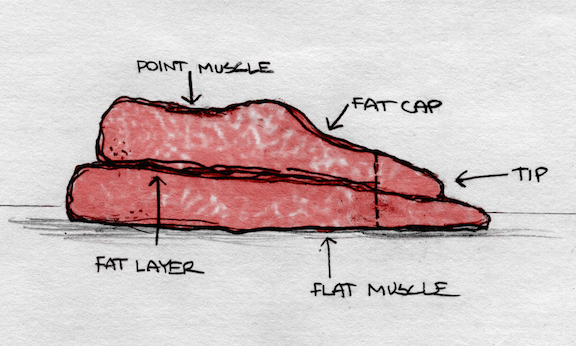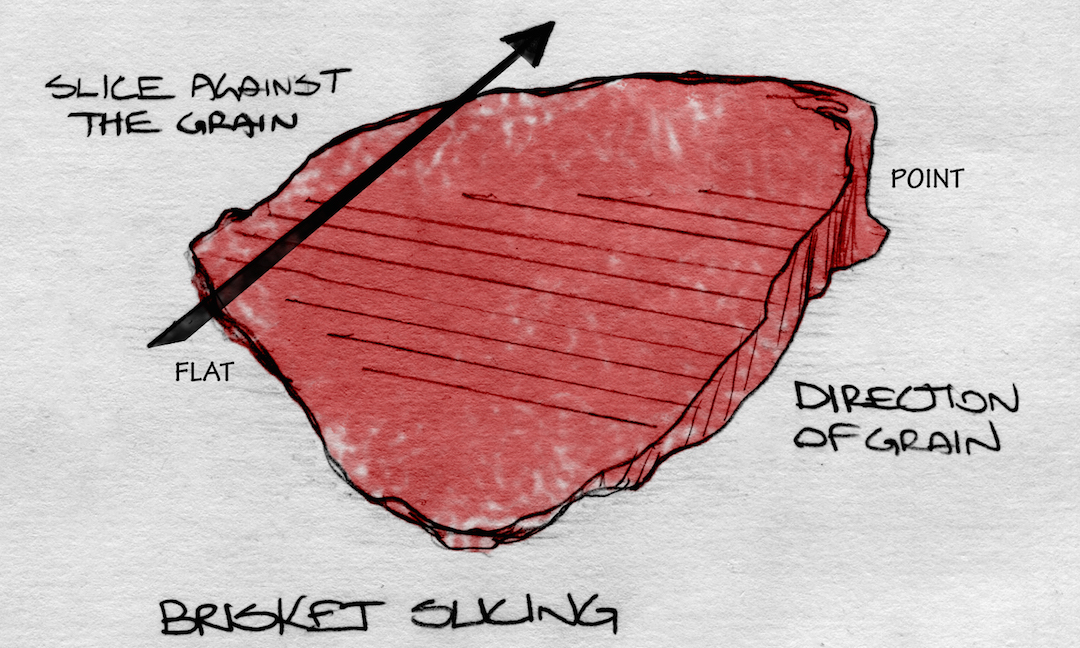It’s a great day for Team Low & Slow – we are thrilled to see “Low & Slow 2” is the #1 BBQ/Grilling book on Amazon’s Hot New Releases list! Many, MANY thanks to the fans, friends, and family for getting us there.
It’s a great day for Team Low & Slow – we are thrilled to see “Low & Slow 2” is the #1 BBQ/Grilling book on Amazon’s Hot New Releases list! Many, MANY thanks to the fans, friends, and family for getting us there.

The packer cut brisket – the brisket of choice and recommended cut when you’re cooking low and slow – is a tricky slab of meat. Butchers know this cut by its Institutional Meat Purchase Specifications number: IMPS No. 120. It is a boneless brisket with the deckle (the fat and lean between the bone and main muscle) removed. These illustrations were cut from the lineup in Low & Slow 2 (see page 85 in the book for reference), but we think they are important images because they show the top and side-view delineation between the point and the flat – the two distinct sections of a packer cut brisket. This is key visual information to know for several reasons:
1) Many barbecue beginners don’t realize that the “Texas barbecue” brisket is this huge, 12 to 15-pound hunk of meat. The “brisket” you typically find in grocery stores is not a packer cut brisket. It is the flat part of a brisket, and it has been heavily trimmed.
2) An untrimmed packer cut brisket has a thick fat cap – the hard shell of fat covering one side of the brisket – and a v-shaped wad a fat that tapers inside the brisket where the point and the flat meet. This illustration makes it easier to understand where the flat and point meet, and how the fat cap covers areas of the point and the flat, which you’ll need to know if you decide to trim the brisket (see page 85 in “Low & Slow 2”). We don’t recommend trimming your very first brisket because this fat protects the meat from drying out (although you will end up cutting a lot of it away when you are slicing and serving the meat).
3) A cooked brisket looks like a misshapen, blackened meteor (and that’s if you’ve done it right), which can make slicing difficult if you don’t understand the direction the grain runs in the two sections (it varies based on where you’re cutting). Some pitmasters remove the point and slice the two sections separately. Others slice the flat until it hits the point, then separate the two sections to slice separately. In the middle of this “BBQ with Franklin” YouTube video, Aaron Franklin slices the flat until it hits the point, then rotates the brisket 90 degrees and slices the brisket with the two sections intact. (Jump to the 6:45 mark to get right to the slicing.)
4) When you’re making Classic Burnt Ends (page 86), you’ll separate the fatty point from the flat on a cooked brisket – you do this by running a sharp knife horizontally along the fat seam between the two sections. The side view of a brisket will help you locate that fat seam.

MIDWEST FRIENDS OF LOW & SLOW: Join us for the Low & Slow BBQ Pitmaster Dinner at Barn & Company on April 29th. Tickets are on sale now! This four-course meal featuring recipes from Low & Slow 2 will be paired with cocktails by Heaven Hill Distillery & beer from Great Lakes Brewing Company!
MENU
Greeting Cocktail – Heaven Hill Distillery
STARTERS paired with Great Lakes Brewery – Elliot Ness
Hot Smoke-Roasted Tri-Tip Sliders with Chimichurri Sauce
Smoked Tomato Bruschetta
ENTREES paired with Great Lakes Brewery Chillwave Double IPA
Pitmaster Porchetta with Salsa Verde
Smoked New Orleans-Style Barbecue Shrimp with crusty French Bread
SIDES
Macque Choux with Smoked Tomato & Corn
Charred Jalapeno Hush Puppies with Smoked Creole Mustard
DESSERT paired with Heaven Hill Distillery
Low & Slow Boozy Bread Pudding (Larceny Kentucky Straight Bourbon)
Call Barn & Company at (773) 832-4000 or e-mail events@barnandcompany.com to reserve your spot today!